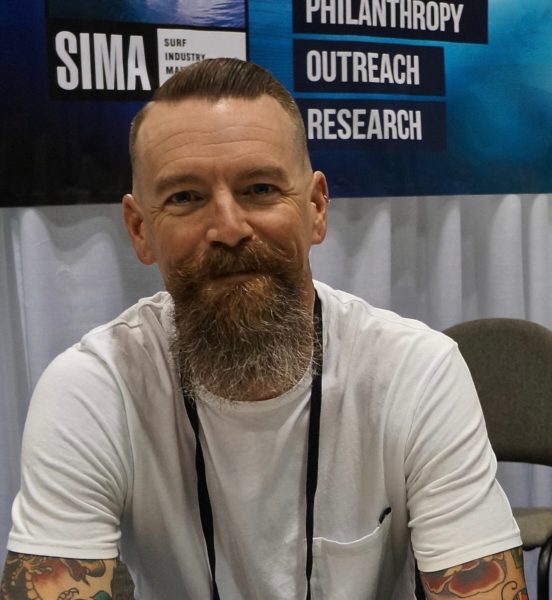We reached out to SIMA Executive Director Sean Smith after hearing about staff changes at the organization.
Shannon Park Zseleczky, the longtime Managing Director, has departed, as has Marketing & Events Coordinator Jordan Schweitzer.
We also wanted to find out how SIMA is working to transform itself to keep up with the evolving surf industry.
Why is SIMA cutting its staff?
SIMA Executive Director Sean Smith: We’re not actually cutting staff here at SIMA. There have been some changes to the staff recently, but SIMA is just like any company that sees people leave for new opportunities or changes being made to best suit the needs of an evolving list of goals and objectives.
Of course, when an organization is as small as SIMA any change of staff is significant. However, we’re very excited to have a SIMA veteran re-joining the staff. Melinda Simpson, whose last name was Carter when she worked at SIMA many years ago, is returning to SIMA today as our Event Manager. We’re very excited as she will hit the ground running and comes back to the staff with an even more well rounded set of skills than when she was first on the team.
How have changes in the surf industry impacted SIMA?
Sean Smith: Changes in the surf industry don’t necessarily mean there’s a significant impact on SIMA. Whenever there are changes, SIMA should be prepared to serve the membership no matter what is happening. And that’s what we’re seeing right now.
Our goals and objectives are shifting a little to address what our members need. The make up of the Board of Directors is evolving to reflect changes in the industry, and over the past 18 years we’ve also had staff changes to meet new needs.
How is the Board evolving?
Sean Smith: We now have more women on the Board of Directors than ever before in SIMA’s history and some brands coming on that haven’t participated at the Board level in the past. We’ll have more we can report on after the elections next month.
Does SIMA still have offices?
Sean Smith: The SIMA staff is still working remotely but we plan to be in offices at the beginning of the year. The lease on our former office was expiring and we decided not to renew because the space was just way bigger than was needed.
How is SIMA trying to evolve?

SIMA Executive Director Sean Smith – SES file photo
Sean Smith: The biggest area of evolution for SIMA began this year with business sustainability and development. SIMA wants to tackle business development issues facing the industry and use the power of a unified front to effect change.
For example, some of our goals for 2020 and beyond are to continue to help the industry move away from traditional poly bags to more sustainable bag solutions, set a deadline goal for the industry to stop printing catalogs, begin reducing and eliminating samples, and create a plan to improve the use of UPC codes at retail.
The goal is to work together to help make individual brands more efficient and therefore make the industry as a whole more efficient. Our members should expect to see more partnerships on the business development side such as the ones with Elastic, a digital sales platform company, and Klarna, a digital payment platform, as SIMA seeks to provide solutions as well as set goals.
Events like Waterman’s and SIMA Awards continue to be very well received. Both will probably see some changes to keep them fresh, but those events will continue to bring the industry together.
Education will also continue to be a major pillar going forward. Our goal with the Speaker Series and Surf Summit is to grow the value and importance of those properties with top speakers and topics that are most important to our members. We’ve also addressed the fact that some people just can’t make every event by posting video of this year’s Speaker Series presentations online.
Where our members will also see some evolution is on the philanthropy or the “giving back” pillar of SIMA. For years, SIMA has brought the industry together to support groups that help protect the health of our oceans and humanitarian groups that use surfing to help those in need.
We will continue to do that through Waterman’s for the environment ,and Float Collective for the humanitarian side, but we need the industry to have a stronger voice. Thus SIMA has partnered with Surfrider Foundation to ensure the industry’s voice is heard on key ocean environment issues, such as offshore drilling and reef protection from harmful sunscreens. We will continue to insert the surf industry’s voice at the state and federal government level.
(Editor’s note: Vissla CEO Paul Naude recently penned an opinion piece about offshore drilling for the San Diego Union Tribune.)
Why is SIMA important to the industry going forward and as we move into an Olympic year?
Sean Smith: SIMA provides a platform for industry leaders to come together and tackle industry problems and opportunities that benefit and strengthen the whole industry. The value of SIMA has always been, and will continue to be, strength in numbers.
Our oceans are under attack. Consumers are demanding more sustainable products and business practices. The cost of doing business goes up every day. By addressing these issues together as an organized group, we will have far more success than going it alone.
And with the Olympics less than a year away, surfing is about to be on the biggest sports stage in the world for the first time ever. With all that our industry is facing right now, the need to work together to shape the future of the industry has never been more important.






